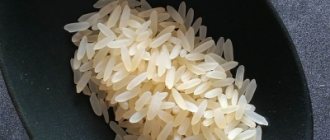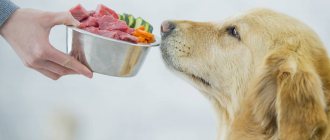Every owner of a furry pet dreams of it being healthy and cheerful. Regular walks, careful care, routine vaccinations, feeding the dog only expensive food, it would seem, are designed to make the life of any dog ideal. But the increasingly common symptoms of food allergies raise bewilderment and natural questions:
- what is allergic dermatitis;
- what foods do not cause allergies in dogs;
- what is the best way to feed a dog?
- what can be given to a dog and what should be completely excluded from the diet;
- how not to confuse the symptoms of food allergies with other diseases;
- What treatment is needed for food allergies?
This is exactly what will be discussed further.
Signs indicating a food allergy
The most common food allergy symptoms that can be found in a dog are:
- The hair begins to fall out unevenly, and focal bald spots may appear all over the pet’s body.
- Itching appears, the dog scratches some areas of the body.
- Ear infections and otitis media occur, the treatment of which is difficult. If your pet is constantly experiencing discomfort, shaking its ears, and discharge from the ears flows out, most likely this is a manifestation of a food allergy.
- Skin infections occur frequently.
- The dog's stool becomes more frequent.
- The pet constantly licks its front paws and anus.
- The dog begins to smell unpleasant; this smell appears not only from the mouth, but also from the entire body of the animal.
- Food allergies in dogs can appear as weeping spots all over the body.
- The animal's eyes constantly water, mucus accumulates in the corners.
We should just not forget that such symptoms can occur with any allergic reaction.
Diagnosis of protein intolerance in dogs
Diagnosis is extremely difficult: the dog still won’t say what exactly and when it ate. In addition, many of the above symptoms could just as well indicate a dozen other diseases, when allergies have nothing to do with it. Therefore, the diagnosis of “protein allergy” can only be made in a well-equipped veterinary clinic.
A physical examination will be done immediately, checking your dog's overall condition and behavior, the veterinarian will check body weight, temperature, blood pressure, heart rate and breathing rate, breathing sounds, reflexes, skin disease, and will include a complete examination of the eyes, ears, nose and mouth
Laboratory tests such as complete blood count (CBC), blood chemistry profile, electrolyte panel, glucose levels, urinalysis and fecal examination will be done to rule out any underlying illness or disease. The veterinarian may also take a skin scraping to rule out bacterial infection or mycosis.
What foods can cause an allergic reaction?
Dogs are most often susceptible to food allergies. Such a reaction can be triggered by any food product; one animal may become allergic to a certain brand of dry food, while another may be allergic to beef or carrots.
There is no specific list of foods that can cause allergic reactions; the nutrition of each dog should be individual; you just need to recognize the food that causes an allergic reaction in time and remove it from your pet’s diet.
But there are still a number of food products to which the animal body most often reacts as an allergen.
- Dry food. Artificial additives, substitutes and dyes, which are present in large quantities in dry food, are components that often cause allergies in dogs. Less commonly, an allergic reaction occurs to soy, cereals and milk powder, which are also components of dry food.
- Chicken meat Recently, pets are becoming more and more allergic to chicken, due to the unscrupulous behavior of chicken meat producers. Potent antibiotics and growth hormones are often introduced into the poultry diet, which can accumulate; the allergenic effect of eating such meat can manifest itself in a dog.
- Egg. An owner who feeds his pet chicken eggs must be prepared for the dog to begin to suffer from an allergy to chicken protein. This delicacy can also be classified as a product that often causes skin manifestations of the disease.
- Fruits and vegetables are red. Dermatitis caused by eating such vegetables and fruits is less common than a reaction to protein. Small dogs that enjoy eating fruit often suffer from this type of allergy.
- Fish and seafood. Before feeding your dog mussels or shrimp, it is worth remembering that such products cause allergic reactions in many people, not to mention animals.
- Products that are harmful to animals and should not be given to your pet. Every dog owner knows about chocolate, sugar, pastries, fried foods and smoked meats. Any product listed is extremely allergenic for furry pets. There is no need to follow the lead of a dog begging for such treats; it is better to give him a special treat purchased at a pet store.
- Beef. This meat extremely rarely causes allergic reactions, just don’t feed it constantly, the dog’s diet should be varied. A mono-diet (feeding only one type of food) can ultimately lead to the development of a variety of diseases.
Features of hypoallergenic food
Hypoallergenic food is a complete, balanced diet that has undergone clinical studies. The composition of such a product necessarily includes vitamins, amino acids, minerals and other substances necessary for the full development of the dog’s body.
A distinctive feature of hypoallergenic food is that it is absolutely harmless for all dogs. That is, it can be given both to relieve acute allergy symptoms and for prevention, which will not prevent your pet from gobbling up healthy delicacies on both cheeks. And such a product is considered not only dietary, but also safe, because it does not contain chemical compounds, dyes, artificial components and other harmful substances. But this applies to packaging from well-known and trusted manufacturers.
Choosing untested products can cause even more harm to your pet. After all, some manufacturers compensate for the low price with various additives (thickeners, dyes, stabilizers, thickeners) and low-grade cheap ingredients.
How to self-diagnose food allergies?
To determine the presence of a food allergy, and not another type of disease, you need to take the following measures:
- If the animal begins to suffer from the above symptoms, and the owner assumes that this is an allergic reaction to a certain type of food, you should start feeding the dog food (natural or expensive hypoallergenic dry food) that it has not eaten before.
- The dog should receive this diet for at least two or even three months. When your pet's health returns to normal, you can return to your normal diet. If symptoms recur, it will become clear that the dog is experiencing an allergic reaction to certain components of its usual diet.
- Quite often such testing has to be carried out with a different set of products until a specific allergen is identified. Despite the complexity and duration of such testing, this is the surest way to rid an animal of food allergies.
Caring for a dog with allergies
First of all, contact a veterinary clinic in Moscow. Follow all veterinarian recommendations, especially regarding nutrition. If possible, switch your dog to a hypoallergenic diet, having previously agreed with your veterinarian.
Take good care of your pet's skin and coat. Allergic reactions in 9 out of 10 cases are accompanied by skin itching and rashes, so stop using hard combs that injure the skin for a while.
Try to temporarily limit your pet’s contact with other animals (for example, while walking). Make sure your new diet contains enough vitamins and minerals necessary for your dog's health.
How is the disease treated?
If the owner does not have the opportunity to independently identify the allergen, he should immediately contact a veterinarian. A good specialist will not make a diagnosis by eye, but will suggest conducting a series of tests, samples and tests to help identify the allergen.
Having identified the irritant, the doctor will prescribe a comprehensive treatment for the sick dog, which should be strictly followed. He will give detailed recommendations on how to treat and how to feed the animal.
If you follow all the prescribed recommendations, your pet's health will quickly improve.
Treatment for this disease includes the following:
- The dog is prescribed a special diet. A special diet recommended by a veterinarian should not include those components to which the body reacts. While your four-legged friend is undergoing treatment, there is no need to feed him vitamins and treats, or give him chewing toys or flour products.
- If there are skin rashes, the doctor will often prescribe a course of antibiotics and antifungal drugs. Such medications will help quickly stop the infection and prevent it from developing again.
- If severe itching occurs, the animal is prescribed antihistamines. It is possible to prescribe glucocorticosteroids; they not only suppress itching, but also reduce the body's sensitivity to allergens.
Introduction of a diet and exit from it.
Replacing regular food with dietary food should occur gradually, including changing the volume of feeding portions. To do this, new products are introduced into the diet in parts. Approximately 15-20% of the target amount for 1 week, gradually bringing it to full. This will help avoid possible unwanted reactions from the digestive system. After all, the digestive organs also need some time to adapt to the new diet. Otherwise, regurgitation, flatulence, diarrhea or constipation are inevitable.
Exiting the diet is also carried out according to this principle. However, such a schedule may not be used for therapeutic diets that are prescribed to treat a serious disease. For example, in case of allergies, intolerant foods are immediately removed from the diet. Or hard-to-digest fatty meat products for liver diseases.
Therapeutic dietary nutrition.
Designed for self-treatment of any diseases. Together with other therapeutic measures, without replacing them. Depending on the stage of the chronic disease, the composition of the diet changes. During the period of exacerbation, the diet is one, during the period of remission - another. Therefore, when the condition normalizes, dietary nutrition designed for the acute period of the disease should also be changed.
In the vast majority of cases, therapeutic dietary nutrition involves abandoning natural feeding. And the transition to special medicated dog food. After all, it is impossible to prepare food on your own that is balanced for a sick body at home. This also requires the absence of contraindications from the teeth and jaws. Wet dog food can also be used. Using wet food can increase your dog's fluid intake. Such food is usually eaten with great appetite. A diet for dogs that involves a combination and alternation of dry and wet food has proven itself to be excellent.
Medical nutrition schemes are prescribed in the acute period of the disease or during an exacerbation of the chronic one. Although in some cases, with a chronic disease, medicinal dietary food for a dog can be prescribed for life. This is quite a difficult task and can only be carried out by a trained veterinarian. There are also preventative dietary regimens. They can also be used for constant daily nutrition in healthy dogs.
Medicinal dog food contains carbohydrates from cereals and a strictly defined amount of protein from lamb, rabbit, duck or fish. As well as healthy fats from nutritionally appropriate oils. Some foods contain fruit pulp and egg powder. Any therapeutic diet for dogs involves the use of only special food, which is much easier to digest than usual.
Problems with joints and spine.
Frequent in large breeds and in older dogs. The incidence of various dysplasias, chondropathy, arthrosis and other diseases of the musculoskeletal system has increased in recent decades. Diet for dogs with such problems is an inevitable and important component of their treatment. The goal of the diet is to improve joint mobility and prevent inflammatory and destructive complications. For this purpose, feed has been created that is enriched with “building blocks” for the connective tissue and cartilaginous structures of the joints and spine. These can be collagen, elastin, organic calcium compounds, hyaluronic acid, glycosaminoglycans, chondroitin. Dietary food for dogs with such diseases is labeled “Mobility”. Therapeutic foods for dogs in this class are: Royal Canin Mobility C2P+, Advance Articular Care, Pro Plan JM.











